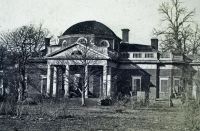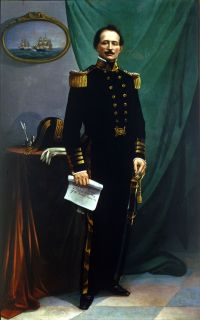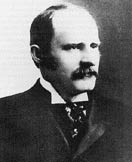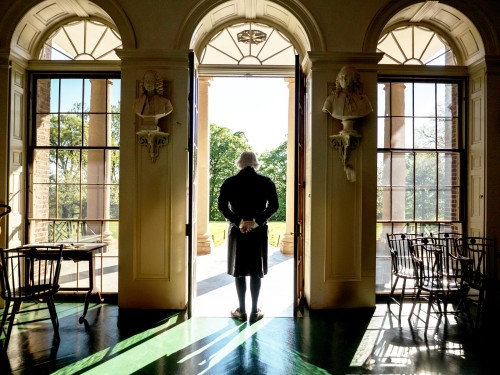The following is condensed from an address, "The Levy Family and Monticello," written by the late Dr. Malcolm H. Stern, Genealogist at the American Jewish Archives, and delivered by Mr. Saul Viener at Monticello on June 7, 1985.
 The history of Monticello does not end with Jefferson's death. Nearly a century passed from the time between Jefferson's death and 1923, the year that the Thomas Jefferson Foundation assumed the stewardship of the property. The story of the intervening years has been recorded with many variations, but of one fact there can be no disagreement: Monticello survives because of the efforts of its two major owners of the period, Uriah Phillips Levy, USN, and his nephew, Jefferson Monroe Levy. These two men and their families held a very modern notion that the houses of great men should be preserved as "monuments to their glory," and their stewardship of the home and property is remarkable and significant.
The history of Monticello does not end with Jefferson's death. Nearly a century passed from the time between Jefferson's death and 1923, the year that the Thomas Jefferson Foundation assumed the stewardship of the property. The story of the intervening years has been recorded with many variations, but of one fact there can be no disagreement: Monticello survives because of the efforts of its two major owners of the period, Uriah Phillips Levy, USN, and his nephew, Jefferson Monroe Levy. These two men and their families held a very modern notion that the houses of great men should be preserved as "monuments to their glory," and their stewardship of the home and property is remarkable and significant.
Uriah Levy: Preserving a Heritage for the Nation
 Uriah Levy's first view of Monticello -- eight years after Jefferson's death -- was dismaying. Upon learning that it was for sale, he decided to buy it and preserve it for the nation. What he acquired was 218 acres of overgrown fields surrounding a dilapidated, almost empty house, for the sum of $2,700. Levy promptly hired Joel Wheeler as overseer to supervise a restoration of both house and garden. Tourists began visiting the property in ever growing numbers and were often guided through the house by Uriah Levy himself. By 1837, he had enlarged his property to 2,700 acres.
Uriah Levy's first view of Monticello -- eight years after Jefferson's death -- was dismaying. Upon learning that it was for sale, he decided to buy it and preserve it for the nation. What he acquired was 218 acres of overgrown fields surrounding a dilapidated, almost empty house, for the sum of $2,700. Levy promptly hired Joel Wheeler as overseer to supervise a restoration of both house and garden. Tourists began visiting the property in ever growing numbers and were often guided through the house by Uriah Levy himself. By 1837, he had enlarged his property to 2,700 acres.
Upon his death in 1862, Commodore Levy left a complicated will, naming the United States as administrator of the estate, to be used as a school for orphans of naval officers. Meanwhile, the Civil War began, and the Confederate government seized and then sold the property to another owner. Following the war, a long period of litigation was required before Commodore Levy's nephew, Jefferson Monroe Levy, became Monticello's sole proprietor.
Jefferson Monroe Levy: Restoring Our History
Nineteen years had passed since Uriah Levy's death, and during that time, the estate had been transformed into a working farm, with pigs rooting in the flower beds, cattle grazing on the West Lawn and being stabled inside the house, and grain stored in the house. Jefferson Levy ousted Wheeler as overseer and began a search for a more appropriate caretaker.
In 1889 he found the highly competent and dedicated Thomas L. Rhodes. The two of them effected a thorough rehabilitation and restoration, purchasing Jefferson's furniture wherever they could find it, and even adding 300 acres to the property.
 Levy served as a Congressman at times during the early 1900s and was encouraged by associates in Washington to turn the property over to public ownership. Though initially reluctant, in 1914 he offered the federal government the opportunity of purchasing Monticello, but after much congressional rhetoric on the subject, no funds were forthcoming.
Levy served as a Congressman at times during the early 1900s and was encouraged by associates in Washington to turn the property over to public ownership. Though initially reluctant, in 1914 he offered the federal government the opportunity of purchasing Monticello, but after much congressional rhetoric on the subject, no funds were forthcoming.
In the depression following World War I, Jefferson Levy found it necessary to put the property on the market. On April 13, 1923 (the 180th anniversary of Thomas Jefferson's birth), the Thomas Jefferson Foundation was formed in New York. The organization negotiated with Levy for the purchase of the property at a cost of $500,000, and has carried on to the present the tradition of preservation established by the Levy family.
